We may receive a commission when you use our affiliate links. However, this does not impact our recommendations.
When preparing stock by hand, the most useful plane is probably the jack plane (sometimes called the fore plane among joiners). Its curved iron allows you to remove a remarkable amount of material with every stroke.
I usually travel with a metal jack (an old Stanley No. 5) because it’s less intimidating in a classroom than demonstrating with a wooden-bodied plane. But I do have a wooden jack that I’ll use at home for my own work.
This week while in England, woodworker Richard Arnold showed me one of his 18th-century jacks that had a rounded sole that matched the rounded iron.
He said the plane is English and dates from the mid-1700s, based on its construction details, including its tote, which is offset from the centerline of the wooden stock. The plane had an Ibbotson iron with no chipbreaker.
Richard, who also collects tools relating to joinery and sash work, said he has seen this rounded sole on early jacks before, though it is not common. The advantage of the shape of the sole is that you can use the entire iron, instead of just the small bit that protrudes from a flat sole.
By tilting the plane, the corner of the iron will cut.
I imagine it also would be useful for dealing with the inside surface of a coopered door, amongst other things.
While I didn’t get to measure the radius of the curve, it looked like the iron was curved with a typical radius (such as 8° or maybe a tad tighter).
Next time I dig out my wooden jack, I might make this modification and give it a go. Or perhaps I’ll radius the sole of my metallic Stanley on an edge sander (this is a joke, Alf. Promise).
— Christopher Schwarz
My book “Handplane Essentials” discusses all manner of jack/fore plane stuff, including how to flatten boards and benchtops with this very useful plane. You can purchase “Handplane Essentials” in the ShopWoodworking.com store.
Here are some supplies and tools we find essential in our everyday work around the shop. We may receive a commission from sales referred by our links; however, we have carefully selected these products for their usefulness and quality.



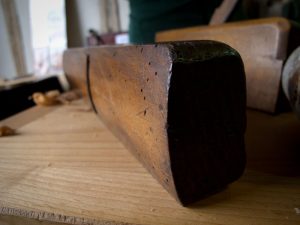
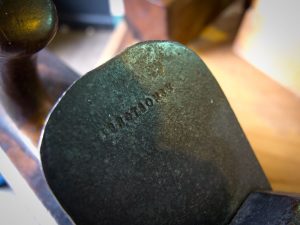
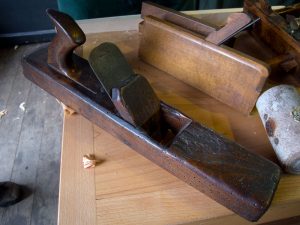





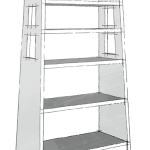
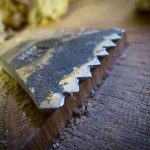
Hi Chris,
Would it be wrong to think of a Jack set up this way as a “Scrub-Jack”? You would think so at least in function.
Have Fun,
Mike Carufe
It seems to me very reminiscent of what often gets called a gutter plane. It has always puzzled me that my great uncle who was likely a finish carpenter had a gutter plane in his toolbox from the 1930’s. http://www.timberframe-tools.com/wp-content/files/toolbox-open.jpg
I was never quite certain why, if he was a finish carpenter, he would need to make gutters. I had previously thought he might have used it as a round to shape crown molding. Now I am thinking it may have been used more often as an aggressive fore plane (what many would now be calling a scrub plane).
Hi Chris–I am an 83 yr old woodworker-great hobby-but I did an apprenticeship in Engineering Patternmaking back
in 1947–1955 we had metal cast planes with key holes in the sole and a series of diff. rounded soles and blades
for planing the occasional curved surfaces required in a special wooden pattern, for a pattern the curve had to be accurate to the engineers drawing for most curved surfaces were left as a cast in the foundry.
James Krenov was also a real advocate of making convex sole planes individually tailored for some projects such as coopered doors and other gentle curves. He goes into the subject at some length in ‘The Fine Art of Cabinetmaking’.
Best regards,
Paul
Very interesting! I just might have to build one like this.
Good to see you at Cressing Temple as well Chris. I’ve also converted a standard flat soled jack having seen that it was one of Alan Peters ‘must have’ tools. I’ve used it on several occasions and found it excellent for the interior curve on a recent cabinet door as well as a small Peters style stool I made a couple of years ago.
Alan Peters mentions in his book that he converted wooden Jack planes to convex soles, much like the plane you show.
I did the same, and found them very useful for coopered doors, as you suggest. They also work very well, cross grain, for scooped tops. There are two cabinets in my books, as well as the seat of my yew meditation stool.
Good to see you and John at the show!
Best wishes,
David Charlesworth
Hey, that’s what my first Stanley looked like after I lapped the sole…
Love the offset totes, though I’m sure it’d make being a lefty 100x more challenging at flea markets if Bailey had made his planes as perfectly balanced as those.